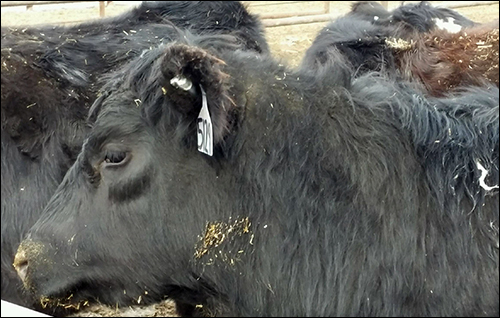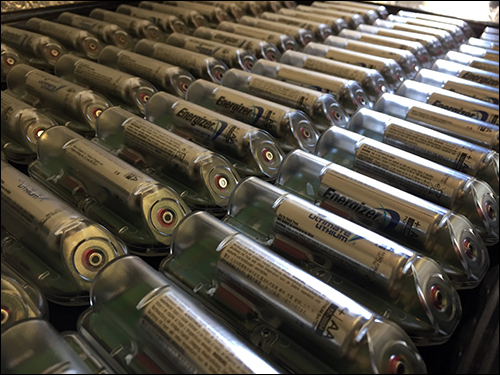The vast majority of the 30 million cows raised for meat in the United States spend the last four to eight months of their lives in confined animal feeding operations (CAFOs), or feedlots, where they are fattened for slaughter. These lots hold up to a million cows at once, and keeping them all healthy is a difficult task. Twenty percent of cattle suffer from illness during their time in feedlots, and two to three percent of them die before slaughter, according to Vishal Singh, CEO of Quantified Ag, a Lincoln, Nebraska-based startup that has developed an ear-tag sensor designed to track a cow’s movements. Quantified Ag’s proprietary algorithms are used to analyze the data collected from the tags. Its cloud-based platform identifies animals that are beginning to show symptoms of illness. The goal is to alert feedlot managers to problems more quickly than human inspectors, who patrol feedlots on horseback, can detect them.
Because cattle innately try to conceal illness in order to lower their susceptibility to predators, it can be difficult to recognize symptoms visually. Sick cattle tend to hang their heads and sometimes drool, especially when they are suffering from respiratory illnesses that make breathing difficult. But because most animals in feedlots spend a great deal of time eating, the angle at which sick animals hang their heads looks only subtly different.
“The core of what we do is to be able to compare data among animals,” Singh explains. “The whole point of the system is to pick out outliers.” To do this, the sensor is designed to collect data on mobility, range of motion and temperature.
Quantified Ag’s ear-tag, powered by a AA battery, contains an accelerometer, temperature sensors, a microcontroller and a Semtech radio module. The tag, roughly the size of a pack of gum, is pierced to the cow’s ear. The sensory data is transmitted to a Semtech gateway, which has a 1-kilometer (0.6-mile) read range and is compliant with the LoRa Alliance‘s communication protocol for low-power wide-area networks (LPWAN). Also integrated into the same housing is the passive low-frequency (LF) RFID inlay that the feedlot uses to electronically identify each cow as it is brought into the feedlot, and throughout its life there, up to the point of slaughter.
Two Nebraska CAFOs—the Darr Feedlot, in Lexington, and Midwest Feeding Company, near Milford—are currently evaluating Quantified Ag’s technology, Singh sats. In total, approximately 1,200 animals have been tagged with Quantified Ag’s sensors across the two CAFOs, which have capacities of 40,000 and 14,000 head, respectively. One Semtech reader is installed at each location.
Quantified Ag’s value proposition is to empower feedlot operators to get an earlier jump on treating sick cows in order to control costs and boost size. “There is an economic hit of about $3.2 billion” across the feedlot industry, Singh says, related to the cost of treating sick cattle and the fact that bovine respiratory disease, the most common ailment in CAFOs, contributes to lower growth rate and, therefore, less meat.
In addition, feedlot managers will soon be required, under a new U.S. Food and Drug Administration rule called the Veterinary Feed Directive, to allow feed containing antibiotics or other drugs to be administered only by certified veterinarians. This change, which is being implemented due to human health concerns associational with the growing use of antibiotic drugs in livestock, means that feedlots will begin administering drugs more judiciously in order to avoid having to pay veterinarians to do so. Detecting and treating sick animals sooner should help control these costs, Singh notes, because it should enable feedlots to effectively treat illness after the initial administration of drugs, thereby reducing the number of subsequent times each animal must be administered drugs
“So far, our system is able to flag sick animals one to three days sooner than the feedlot workers are able to, via visual inspection,” Singh says, regarding the pilot tests. “It’s a blind study. So, there’s a section of animals that are tagged, but the feedlot workers are not given access to the data.” Veterinary personnel working with Quantified Ag to run the pilots collect data that documents the moments when feedlot workers flag potentially ill animals, and then compare that to when the analyzed data first detected signs of illness. The three- to four-day gap is the difference.
The goal, Singh says, is for Quantified Ag to be able to retrieve the sensor from each animal at the point of slaughter, deconstruct the device, remove the RFID tag (which can be used only once, in order to avoid duplicative listings in the federal registry) and then build the sensors and microcontroller into a new sensor tag containing a new battery. He declines to share the likely costs of using Quantified Ag’s products, which will be sold as a subscription service that includes the ear tag hardware, nor how soon feedlots are likely to reap a return on investment.
Quantified Ag is not the only company that has developed a sensor-based approach to tracking cattle health in feedlot settings. Precision Animal Solutions, based in Manhattan, Kansas, uses ultrawide-band (UWB) tags integrated into an ear tag in order to track each cow’s precise movements inside its feeding pen. The company uses this data to then estimate which animals are showing signs of illness. However, because UWB is based on triangulation, three readers must be mounted in each pen.
On America’s Greatest Makers, a reality television show created by Intel that is currently running on the Turner Broadcasting System cable channel, one of the contestants is developing a similar solution for ranchers. The system, known as Herddogg, employs sensor ear tags that transmit data collected either by readers mounted to fence posts or by compact wireless readers mounted to cattle dogs that direct the grazing animals.
Editor’s note: An earlier version of this story said that up to 70 percent of cattle get sick during their time in feedlots. In fact, it is 20 percent. Also, the time spent in feedlots range from four to eight months, not four to six months as previously described. We regret the errors.



